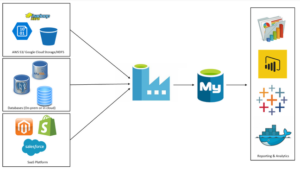Building a data warehouse from scratch is no easy task, but it can be made easier with the right steps and considerations. With proper planning and execution, businesses can create a powerful data warehouse capable of storing and analyzing large amounts of data. This article will outline the steps businesses should take to build a data warehouse from scratch.
1. Identify Business Requirements
The first step to building a data warehouse is to identify the business requirements. This should include understanding the scope of the project, the data sources and how the data needs to be accessed and used. It is important to consider the goals of the project and the desired outcomes. Once the requirements are identified, they should be documented and used as a reference throughout the data warehouse building process.
Next, the data sources should be identified. Companies should consider both internal and external sources, and the data should be cleaned and validated to ensure accuracy and completeness. The data should also be organized into logical categories to make it easier to query and access. It is also important to determine what types of data should be included in the data warehouse, as well as any data that should be excluded.
Finally, the stakeholders of the data warehouse should be identified. This includes the people who will be using the data warehouse, such as business analysts, data scientists, and IT staff. Understanding the user groups allows companies to plan accordingly and ensure that the data warehouse meets their needs.
Here are some resources to help you understand business requirements for a data warehouse:
- https://www.techopedia.com/definition/28727/business-requirements
- https://www.ibm.com/topics/business-requirements
2. Choose the Data Warehouse Platform
Once the business requirements have been identified, companies should choose the data warehouse platform that is most suitable for their needs. There are several types of data warehouse platforms available, ranging from on-premise to cloud-based. Companies should consider factors such as cost, scalability, security, and features before making their final decision.
It is also important to consider the data structures that the data warehouse platform supports. This includes the type of data, such as structured or unstructured, as well as the format of the data, such as CSV, JSON, or XML. Additionally, companies should evaluate the functionality of the data warehouse platform to ensure that it meets their needs.
Finally, companies should consider any integration or automation capabilities that the data warehouse platform offers. This includes APIs, data connectors, and other integrations that can help streamline the data warehouse building process.
Here are some resources to help you choose a data warehouse platform:
- https://aws.amazon.com/redshift/
- https://cloud.google.com/bigquery
- https://azure.microsoft.com/en-us/services/synapse-analytics/
- https://www.snowflake.com/
3. Design the Data Warehouse Schema
The next step is to design the data warehouse schema. This includes defining the tables, columns, relationships, and constraints that will be used to store and organize the data. It is important to consider the structure of the data, as well as any potential performance issues, when designing the schema.
The data warehouse schema should be designed with scalability in mind. Companies should plan for future growth and ensure that the data warehouse can accommodate additional data sources and data types. Additionally, it is important to ensure that the schema is flexible enough to handle changes in the data.
The data warehouse schema should also be designed with security in mind. Companies should consider the access control mechanisms that will be implemented, such as encrypting sensitive data, enforcing authentication and authorization, and auditing user access.
Here are some resources to help you design a data warehouse schema:
- https://www.vertabelo.com/blog/technical-articles/data-warehouse-schema-star-schema-vs-snowflake-schema/
- https://www.talend.com/resources/star-schema-vs-snowflake-schema/
4. Extract, Transform, and Load (ETL)
The next step is to extract, transform, and load (ETL) the data into the data warehouse. This involves extracting the data from the data sources, transforming the data into the desired format, and loading the data into the data warehouse. Companies should consider factors such as data accuracy, data type conversions, and data integrity when performing the ETL process.
Companies should also consider the efficiency of the ETL process. This includes determining how often the data needs to be updated, as well as the best methods for loading the data into the data warehouse. Additionally, companies should consider automation or scheduling capabilities to automate and optimize the ETL process.
Here are some resources to help you with ETL:
- https://www.talend.com/resources/what-is-etl/
- https://airflow.apache.org/
- https://www.informatica.com/products/data-integration/powercenter.html
5. Implement Data Quality Controls
Data quality is an important consideration when building a data warehouse. Companies should implement data quality controls to ensure that the data is accurate and complete. This includes validating the data, auditing the data, and performing data cleansing. Additionally, companies should consider techniques such as using data dictionaries and data profiling to ensure data quality.
Companies should also consider deduplication techniques to ensure that the data is accurate and complete. This includes identifying duplicate records and merging them into a single record. Additionally, companies should also consider techniques such as outlier detection and data enrichment to improve the quality of the data.
Here are some resources to help you implement data quality controls:
6. Implement Security Measures
Data security is an essential part of building a data warehouse. Companies should implement security measures to protect the data from unauthorized access. This includes encrypting the data, enforcing authentication and authorization, and auditing user access. Companies should also consider implementing access control mechanisms, such as role-based access control (RBAC), to limit access to the data.
Additionally, companies should consider implementing data loss prevention (DLP) measures. This includes monitoring user access and activity, as well as implementing measures to prevent data leakage. Companies should also consider deploying security tools, such as firewalls and intrusion detection systems, to protect the data from malicious attacks.
Here are some resources to help you implement security measures:
7. Test and Optimize
Once the data warehouse is built, it should be tested and optimized for performance. Companies should consider factors such as query performance, scalability, and availability when testing the data warehouse. Additionally, companies should use benchmarking tools to test the performance and scalability of the data warehouse.
Companies should also consider optimizing the data warehouse for performance. This includes optimizing the data structures, indexes, and queries for better performance. Additionally, companies should consider using data compression techniques to reduce the storage size of the data warehouse.
Here are some resources to help you test and optimize your data warehouse:
- https://www.talend.com/resources/etl-testing/
- https://docs.aws.amazon.com/redshift/latest/dg/c_performance_best-practices.html
8. Provide Access
The final step is to provide access to the data warehouse. Companies should consider the user groups that will be accessing the data warehouse and how they will be accessing the data. This includes setting up user accounts, providing access to the data warehouse, and enforcing authentication and authorization. Additionally, companies should consider deploying tools, such as business intelligence (BI) and analytics tools, to provide users with easy access to the data.
Building a data warehouse from scratch requires careful planning and execution. With the right steps and considerations, companies can create a powerful data warehouse capable of storing and analyzing large amounts of data. By following the steps outlined in this article, companies can ensure a successful data warehouse build.
Here are some resources to help you provide access to your data warehouse:
- https://powerbi.microsoft.com/en-us/
- https://www.tableau.com/
- https://www.qlik.com/us/products/qlikview
These are the high-level steps involved in building a data warehouse from scratch. The exact process may vary depending on your specific requirements and the data warehouse platform you choose.



